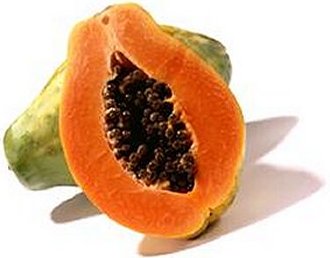Introduction
Papain is a cysteine hydrolase (EC 3.4.22.2) that is found naturally occurring in Papaya(Carica papaya). Papain is extracted from the latex, leaves and roots of the papaya tree. Papain is a protease commonly used for cell isolation, protein structural studies, cleaving antibodies, and various other research techniques. In addition to use in research, it is commonly used in industry to tenderize meats, remove skin from hides, and clean soft contact lenses.

History
Papain was first explorer back in 1873 by G.C. Roy, who studied papaya juice. Later, papain was extracted and named by Wertz and Bouchut who noticed it had proteolytic properties. Papain was the second enzyme to have it's structure determined by x-ray crystallography. Extensive research has be done on the structure and activity of papain and its
Structure
Papain is formed from a peptide that is 212 amino acids in length. It consists of 25% and 21% . The structure also consists of three between . The disulfide bonds exist between Cys 63 and Cys 22, Cys 200 and Cys 153, and Cys 56 and Cys 95. Another important residue to the structure is Cysteine 25 which has a sulfhydryl group that plays a major role in the active site activity[[1]].
The in papain are primarily located toward the inside of the enzyme or paired by hydrophobic interactions with other hydrophobic residues to exclude water. The are located facing the exterior, in the active site, or paired with other charged residues. The charged and polar residues are hydrophilic therefore do not orient themselves to exclude water or solvent. The charged face outward due to their hydrophilic nature.
Active Site and Mechanism
The active site of papain has a including CYS 25, HIS 159, and ASN 175.
Image:Papain2.jpg This triad interacts with the substrate to catalyze the reaction. The sulfur from CYS 25 attacks the backbone amine on the substrate forming a tetrahedral intermediate. Next, the carbonyl is reformed and the carbon nitrogen bond is broken. A water associated with a nitrogen on HIS 159 then attacks the carbonyl forming a second tetrahedral intermediate. The carbonyl then reforms breaking the carbon-sulfur bond. This leaves a carboxy group on the end of one piece of the substrate and an amino group on the end of the other piece.
There are many inhibitors of cysteine proteases like papain, including antipain, cystatin,

